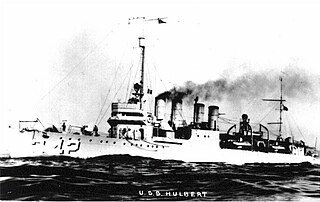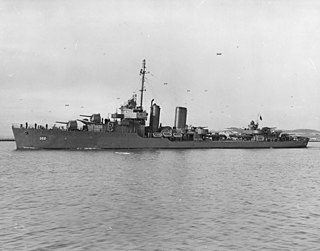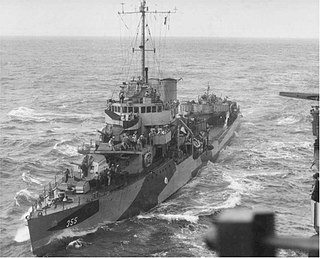
The Mahan-class destroyers of the United States Navy were a series of 18 destroyers of which the first 16 were laid down in 1934. The last two of the 18, Dunlap and Fanning, are sometimes considered a separate ship class. All 18 were commissioned in 1936 and 1937. Mahan was the lead ship, named for Rear Admiral Alfred Thayer Mahan, an influential historian and theorist on sea power.

USS Goldsborough (DD-188/AVP-18/AVD-5/APD-32) was a Clemson-class destroyer in the United States Navy during World War II. She was the second Navy ship named for Rear Admiral Louis M. Goldsborough (1805–1877). Entering service in 1920, the ship had a brief active life before being placed in reserve in 1922. Goldsborough was reactivated for World War II and was used as an aircraft tender, destroyer and high speed transport in both Atlantic and Pacific theaters. Following the war, the ship was sold for scrapping in 1946.

USS Wright (AZ-1/AV-1) was a one-of-a-kind auxiliary ship in the United States Navy, named for aviation pioneer Orville Wright. Originally built as a kite balloon tender, she was converted into a seaplane tender after kite balloons were no longer used.
USS Medusa (AR-1) was the United States Navy's first purpose-built repair ship. She served in the U.S. Navy from 1924 to 1946.

USS McFarland (DD-237/AVD-14) was a Clemson-class destroyer in the United States Navy during World War II. She was named for American Civil War sailor and Medal of Honor recipient John McFarland.

USS Childs (DD-241/AVP-14/AVD-1) was a Clemson-class destroyer in service with the United States Navy from 1920 to 1945. She was scrapped in 1946.

USS Williamson (DD-244/AVP-15/AVD-2/APD-27) was a Clemson-class destroyer in the United States Navy during World War II. She was named for Commander William Price Williamson.

USS Gillis (DD-260/AVD-12) was a Clemson-class destroyer in the United States Navy. She was named for Commodore John P. Gillis and Rear Admiral James Henry Gillis.

USS Stoddert (DD-302/AG-18) was a Clemson-class destroyer in the United States Navy following World War I. It was named for Benjamin Stoddert.

USS Anthony (DD-515), a Fletcher-class destroyer, was the second ship of the United States Navy to be named for Marine Sergeant Major William Anthony (1853–1899).
USS Yarborough (DD-314) was a Clemson-class destroyer in the United States Navy.

USS Hulbert (DD-342/AVD-6) was a Clemson-class destroyer in the United States Navy following World War I. She was named for Henry Hulbert.

The third USS Worden (DD-352) was a Farragut-class destroyer in the United States Navy during World War II. She was named for John Lorimer Worden.

USS Aylwin (DD-355) was a Farragut-class destroyer, and the third ship of the United States Navy to be named for Lieutenant John Cushing Aylwin (1778–1812).

USS Jarvis (DD-393), was a Bagley-class destroyer and the second of three United States Navy ships to be named after James C. Jarvis, a U.S. Navy midshipman who was killed at the age of 13 during the Quasi-War with France. She saw service in the Pacific during World War II and participated in the invasion of Guadalcanal. The destroyer was sunk to the south of Guadalcanal on 9 August 1942, with all hands - one of only two American major surface warships to be lost in World War II with no survivors.

The second USS Conyngham (DD-371) was a Mahan-class destroyer used in the United States Navy before and during World War II. She was named after Gustavus Conyngham.

The USS Altair (AD-11) was the lead ship of a class of three destroyer tenders. She was named for Altair, the brightest star in the constellation Aquila.

USS Blair (DE-147) was an Edsall-class destroyer escort in service with the United States Navy from 1943 to 1946 and from 1951 to 1960. She was scrapped in 1974. Blair was named in honor of Chief Machinist's Mate Eugene Blair, who was awarded the Silver Star posthumously for his brave actions when his ship was attacked and bombed by Japanese planes near Port Darwin, Australia, in mid-February 1942.

USS William M. Hobby (APD-95), ex-DE-236, was a United States Navy high-speed transport in commission from 1945 to 1946.

USS Pavlic (APD-70) was built by Dravo Corporation at Pittsburgh, Pennsylvania as a Buckley-class destroyer escort. Pavlic was launched 18 December 1943 and towed to Texas for refitting as a United States Navy high-speed transport. Pavlic was in commission from 1944 to 1946, serving in the Okinawa campaign as a radar picket ship. Pavlic was decommissioned 15 November 1946. After more than 20 years of inactivity in reserve, she was stricken from the Navy List on 1 April 1967. On 1 July 1968, she was sold for scrapping to North American Smelting Company.



















